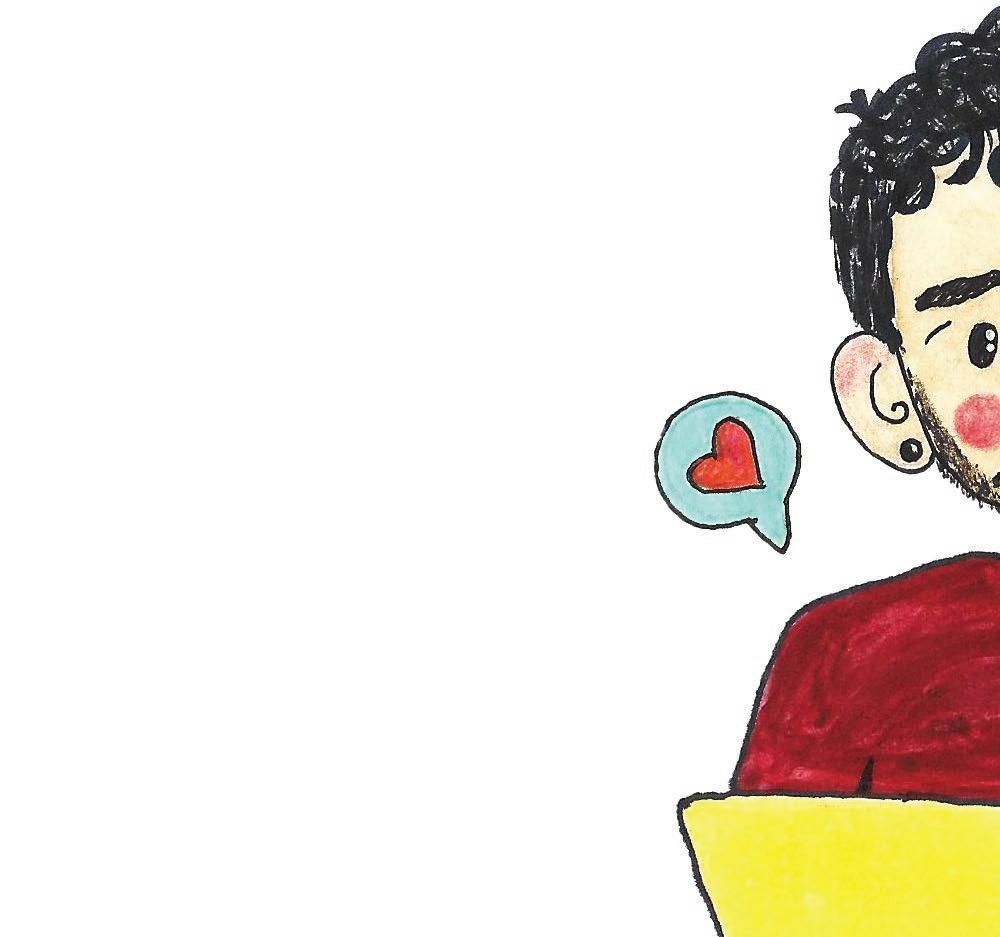
11 minute read
the guide
from Guide for Pride
by MKC Maribor
Political activism
To a degree, we all have loving environments where we feel accepted, even with all of our diff erences. But at the same time, most of us face messages of hatred, intolerance, rejection and condemnation in our daily lives. LGBTQIA+ people are routinely denied the right to self-determination, selfunderstanding and self-realization. There are many skeptics that call into question the justifi cation and legitimacy of a parade of love, freedom and pride; some reject the idea simply because they’re convinced that they already live in a progressive, liberal, seemingly free society. The reality is that pride parades must exist for as long as LGBTQIA+ people cannot fully participate in public life while freely expressing their identity or love to the same extent as those who enjoy that privilege by default. For as long as that privilege is denied to those who only experience true freedom one day out of the year, pride parades need to remain relevant and visible—not just in the LGBTQIA+ community, but in society as a whole.
Advertisement
Any society is only as free as its most vulnerable members! That is why supporting projects that advocate for freedom is of the utmost importance in our collective fi ght for that goal.
Finances
When building the fi nancial plan for your event, keep in mind that many diff erent logistical aspects need to be considered. Don’t sell out – pride parade is a protest.
Pride parade march
• Security: the biggest cost. This usually involves hiring a security company. The scope depends on the local environment, but some level of security is strongly recommended. In our case, police protection was necessary; know the conditions in your city or country. • Stage: this includes sound technicians and stage management. If you opt for a DJ truck, the setup can be more improvised. • Decoration and props: merchandise and other material, including flags, banners, balloons, socks, T-shirts, etc. • Permits: various fees and expenses related to event applications. • Cleaning service, health security
Always set aside 10% all funds for unexpected costs.
the guide
How to get funding?


1. Apply for an Erasmus+ project. Have a youth work approach to your Pride event to get volunteers and coverage of some costs). 2. Look for local/national grants for small projects. 3. Contact international foundations such as Astrea, OSEF, the Open Society Foundation, the Interpride Solidarity Fund, etc. 4. Start a crowdfunding campaign. 5. Open PayPal and bank accounts people can donate money to. 6. Start a campaign using existing crowdfunding tools (watch out for the percentage that the platforms take). 7. Ask foreign embassies for support. 8. Organize a fundraising event. 9. Sell merchandise and other promotional material: T-shirts, creative products, rainbow motifs, flags, bags, stickers, lighters, etc. 10. Collect donations by setting up donation boxes. 11. Ask people to donate materials (banner making supplies and any other items you need). 12. Contact European parliament members from your country and ask them for help. 13. Secure an honorable sponsorship from the mayor’s office or some other city or local authority—this can reduce permit costs.
Donations
For the parade, try to use donations rather than offi cial sponsorships. This is a good way to raise some extra money and get public fi gures, groups and companies to support the parade.
A donation is usually an unconditional payment or contribution in money or goods from a physical or legal entity received by an individual, institution, religious community, chamber, representative union or other recipient. There is no obligation to repay the donor and is not used to pay for products or services.
A sponsorship is a business collaboration between a sponsor and the recipient they’re supporting. In return, the sponsor expects goods, services or access to the commercial potential of the recipient.
Ways physical or legal entities can donate money:
• Online with the help of tools such as crowdfunding, PayPal, direct transfer, etc. • In person at benefits and fundraising events, via a donation box or at other events leading up to the parade.
MKC Maribor is a public entity, so we require a form to be fi lled out for every donation from a physical entity to ensure the traceability of funds. The form was made at the request of the accounting department.
the guide
Legal formality Security
Obtaining the necessary permits for the parade is similar to most public events. As we fi led the paperwork, we were informed of any additional steps. Most of this time was spent coordinating permits for the route of the parade and road closures. About ten days before the event, an inspection determined whether we had all the permits and whether the event met security standards. The entire process took approximately two months.
One of the challenges was assessing the number of participants. Since we were organizing the parade for the fi rst time, it was diffi cult to estimate the attendance, which was a requirement for some of the applications.
We were required to obtain the following:
• consent to the use of public areas, • consent to block a municipal road, • consent to a roadblock by a local busservice operator, • permission to use audio devices, • notification to the city district, • health risk assessment for participants, • statement on providing emergency medical assistance, • statement on providing cleanup after the event, • statement on the erection of temporary facilities, • statement regarding the entry and use of drones and other guided and non-guided flying objects, • statement of non-use of open fire. Our base guideline in organizing the parade was ensuring the safety of all participants. Security is one of the most important aspects of any Pride event, so we spoke to experienced organizers to learn from their practices. These include safety tips given before and during the parade, especially regarding the route and safe behavior, as well as those for aft er the event, such as leaving in groups and not displaying Pride-themed symbols to avoid being targeted.
Due to the climate in Maribor, we opted for police protection. The police also advised us in terms of safety and practical concerns, from selecting wide streets and planning around potential obstacles to ensuring access to parking for participants. We remained in contact and exchanged information with safety implications throughout the organizing stages.

To bolster safety, we hired a security service with previous experience protecting Pride events. A security plan was prepared with input from both security and the police. The risk assessment changed during the preparations for the parade, so details like the number of offi cers involved were modifi ed as needed.
Requirements will vary from city to city, so plan ahead and check what you need.

the guide
Campaign
Although a Pride campaign has some specifi c aspects, it’s otherwise similar to any other marketing campaign. It’s a form of promotion created to reach a specifi c goal. In order to achieve it, here are some steps to take:

1. Decide on a clear and concise goal. Create a message with a slogan and design the visual theme and logo. 2. Make a timeline and action plan. Set deadlines for specific activities; delegate responsibilities to team members. 3. Create your campaign budget. Divide it into different categories (promo materials, online campaigns, supporting events, etc.). 4. Get the word out. Decide on your target audience (age, identity, orientation, etc.); choose effective tools to spread the word and promote your cause (word of mouth, e-mail marketing, social media, mainstream media, posters in different venues). 5. Contact people. Talk to the mayor’s office, the authorities, the police, the press, security, waste management, community members and any other services you’ll need. 6. Order supplies needed for the events. This includes flags, banners, posters, cards, decorations and other promotional material. 7. Organize supporting events. You can support the main event with exhibitions, theatre performances, storyte hibitions, theatre performances, storytelling get-togethers, documentaries, art contests, workshops, picnics, debates, parties, etc. 8. Organize the pride march. More on that in the logistics chapter. 9. Organize an after-party. Secure the venue, promote the event and hire DJs, performers and security. TIP: How to create a message?
• Listen. Stay aware of the current sociopolitical situation in your community; what is missing from it or needs addressing? • Stay simple and short. • Brainstorm and get feedback from your peers first. • Do research on how to best influence your target audience.
Support from the (local)community

• Ask the local community for the support by organizing a simple guerilla action.
CASE STUDY: We asked local organizations, public bodies, museums, cafés and others to hang out or fl y a rainbow fl ag on the day of the parade. If they didn’t have one, we rented it to them. We also invited them to take a picture of the fl ag and post it on social media as a show of support.
• Get support letters and invite influential or relevant people or organizations to participate in your campaign and publicly support you; they can also join the parade.

CASE STUDY: We contacted LGBTQIA+ organizations in Slovenia and neighboring countries to ask for public support. We also got in touch with the mayor, international embassies (which contacted us to express interest in the event), local political parties and organizations, other marginalized groups, well-known LGBTQIA+ individuals, other celebrities and public fi gures and others in order to get as many allies as possible. We even wrote to the UEFA president regarding hooligan threats and received an answer that was shared through social media and in the press.
the guide
Public relations

• Maintain a consistent visual identity that includes a logo, promotional materials, banners, posters, fliers, brochures, social media posts, etc. • Decide on the main slogan and political message. • Have an active online presence and update your social media channels (have an official Instagram and Facebook page, TikTok account, etc.); create a public Facebook event. • Make a promotional video. • Send out an official press release before and after the pride parade. • Take care of media representatives responsible for contact with the media; more tips in the next chapter. • Organize supporting events to promote the parade (fundraisers, performances, art exhibitions, etc.). • Build support in the local community with invitations to events, inclusive campaigns, initiatives, etc. • Make an official video summary after the parade.
Communication with the press
When speaking with the press, it’s important to stick to your goals and get the right message across. Do not speak for others, especially specifi c people, unless they agree not to stay anonymous. Be prepared and refuse to answer questions that are too personal or inappropriate or if you don’t feel informed enough to discuss them. Try to stay patient if the reporters are being provocative.
If necessary, politely correct any errors and ex-plain the terminology. You have the right to see footage of the interview or read the copy before it’s published. Make sure you’re not being misrepresented and correct your statements so you can send out the message you wanted to share in the fi rst place.


the guide
The march logistics checkbox
Before the march
Take care of security (police and other security services).
Plan a detailed timeline and create an organizer handbook for the entire day.
Define the starting point, the route and the ending point of the march.
Delegate properly described tasks to your volunteers.
Decide on the locations that will serve as meeting points.
Exchange contacts between organizers and volunteers.
Plan and publish the event lineup, including the entertainment and political program before and after the march).
Decorate the truck.
Prepare scenarios for different weather conditions.
Provide refreshments for volunteers, guests and, if possible, participants.
Set up accommodation for out-of-town volunteers, speakers, performers, etc.
Set up the technical equipment (sound system, generator, microphones, stage props, truck, etc.)
Have an official photographer(s).
Have emergency services on standby.
Ask for help from other LGBTQIA+ organizations. During the march
Deliver flags banners and other materials (balloons, umbrellas, amnesty rainbow crowns, flags, …).
Have a merchandise table for materials (T-shirts, flags, …)
Deliver paper bracelets to for counting an amount people that attended the march..
Be active on social media (Instagram, Facebook, ,..)
Have name tags for organizers, press and security.
After the march
Take care of cleaning.
Prepare for the afterparty.
You need people responsible for:
coordinating volunteers coordinating the stage program coordinating security hosting the program decorations and visuals general logistics technical equipment social media speaking to the press reception of guests, speakers etc. access for disabled people sign language interpreting




